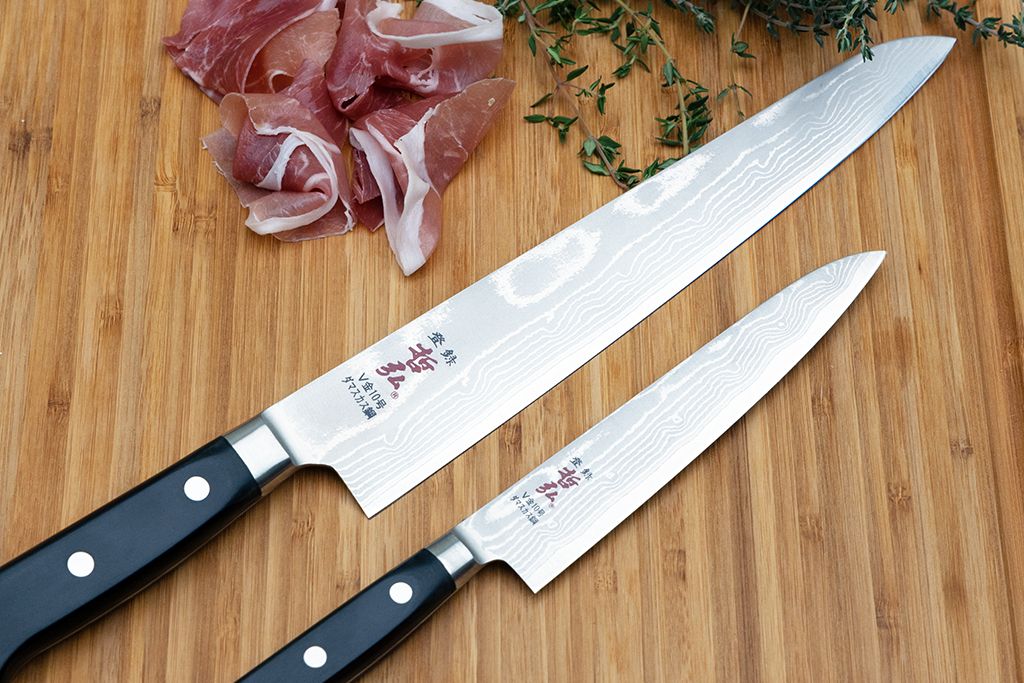A Sujihiki-slicer knife is designed to effectively cut thin slices of finished products, vegetables, fish, and others. It has a special gastronomic role in the home and professional kitchens. Such a knife allows you to effortlessly make a beautiful and presentable table setting by cutting perfectly thin slices to decorate dishes.
FEATURES OF THE KNIFE-SLICER
This knife for the thin cutting of sausage, cheese, and other products has a characteristic appearance. We list the design features:
- thin, narrow, and straight blade 20-30 cm long;
- pointed tip almost in line with the cutting edge;
- the presence of a bolster - a thickening between the handle and the blade for the optimal balance of the knife;
- a safety guard that protects fingers from slipping and cuts during cutting;
- fine reduction of the cutting edge - for easy sliding along the product's fibers.
Such a thin slicing knife is ideal for cutting meat for shawarma, removing thin slices of sturgeon, ham, carpaccio, and other meat and fish delicacies.
OTHER KITCHEN KNIVES FOR THIN CUTTING
Depending on what kind of product needs to be cut, cooks can use highly specialized blades for this purpose. In the highly professional Japanese instrument category, there are several models designed specifically to work with certain types of food.
We list the possible options:
Nakiri is a Japanese knife for thinly cutting vegetables (shredding). The blade is wide and rectangular. A vertical cutting technique is provided - up and down movements of the hand.
Fillet - suitable for slicing fish and meat fillets. The design is similar to a slicer; only the blade is narrower, the tip is sharper.
Yanagiba - a knife for thinly slicing fish, including sushi and sashimi. The blade is long, thin, and very sharp; it allows you to cut the chilled fillet, preventing breakage into fibers.
Santoku is a universal blade, the Japanese analog of the chef. Such a knife for cutting thin slices is less suitable, but with sufficient skill of the cook, it will be possible to get even, neat slices from different types of products.
BLADE MATERIALS
When choosing a knife for filigree cutting, the hardness of the hardened steel and the sharpness of the cutting edge is decisive. It is unlikely that you will make a neat, even cut with a slicer with a blunt blade. The optimal materials for a blade that keeps sharpening for a long time are:
- Single-layer high carbon steel hardened to 56 HRC and above. This blade is very hard and sharp does not require correcting and sharpening for several months.
- Multilayer Damascus steel. It is packaged steel of several types. In the center, there is usually a high-carbon core, which provides excellent cutting properties. The facings are made of less carbon steel that protects the blade from corrosion and mechanical damage.
- Zirconia ceramics. The material is obtained from zirconium ore, subjecting it to purification and sintering blanks at very high temperatures. Sharpening is carried out with diamond-coated abrasives. Such a knife is extremely sharp and hard and provides an even and easy cut.
It is also worth considering that the knives of Japanese brands have a minimum sharpening angle of 15-20 degrees. Due to this, it is possible to minimize the contact area of the cutting edge with the product, which means that cutting is easier and more accurate. European brands cannot boast of such characteristics of their products; their sharpening angle is 30-45 degrees.



POST COMMENTS
0 COMMENT(S)